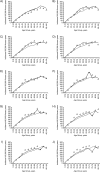Interpreting overdiagnosis estimates in population-based mammography screening
- PMID: 21709144
- PMCID: PMC3132806
- DOI: 10.1093/epirev/mxr009
Interpreting overdiagnosis estimates in population-based mammography screening
Abstract
Estimates of overdiagnosis in mammography screening range from 1% to 54%. This review explains such variations using gradual implementation of mammography screening in the Netherlands as an example. Breast cancer incidence without screening was predicted with a micro-simulation model. Observed breast cancer incidence (including ductal carcinoma in situ and invasive breast cancer) was modeled and compared with predicted incidence without screening during various phases of screening program implementation. Overdiagnosis was calculated as the difference between the modeled number of breast cancers with and the predicted number of breast cancers without screening. Estimating overdiagnosis annually between 1990 and 2006 illustrated the importance of the time at which overdiagnosis is measured. Overdiagnosis was also calculated using several estimators identified from the literature. The estimated overdiagnosis rate peaked during the implementation phase of screening, at 11.4% of all predicted cancers in women aged 0-100 years in the absence of screening. At steady-state screening, in 2006, this estimate had decreased to 2.8%. When different estimators were used, the overdiagnosis rate in 2006 ranged from 3.6% (screening age or older) to 9.7% (screening age only). The authors concluded that the estimated overdiagnosis rate in 2006 could vary by a factor of 3.5 when different denominators were used. Calculations based on earlier screening program phases may overestimate overdiagnosis by a factor 4. Sufficient follow-up and agreement regarding the chosen estimator are needed to obtain reliable estimates.
Figures


References
-
- de Koning HJ. Mammographic screening: evidence from randomised controlled trials. Ann Oncol. 2003;14(8):1185–1189. - PubMed
-
- International Agency for Research on Cancer. Volume 7: breast cancer screening. In: Vainio H, Bianchini F, editors. IARC Handbooks of Cancer Prevention. Lyon, France: IARC Press; 2002.
-
- Waller M, Moss S, Watson J, et al. The effect of mammographic screening and hormone replacement therapy use on breast cancer incidence in England and Wales. Cancer Epidemiol Biomarkers Prev. 2007;16(11):2257–2261. - PubMed
Publication types
MeSH terms
LinkOut - more resources
Full Text Sources
Medical

